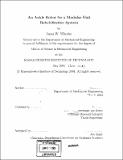An ankle robot for a modular gait rehabilitation system
Author(s)
Wheeler, Jason W. (Jason William)
DownloadFull printable version (16.98Mb)
Other Contributors
Massachusetts Institute of Technology. Dept. of Mechanical Engineering.
Advisor
Hermano Igo Krebs.
Terms of use
Metadata
Show full item recordAbstract
Patients with neurological disorders, such as stroke survivors, can be treated with physical rehabilitation to regain motor control and function. Conventional therapy techniques are labor intensive and non-standardized. This is especially true in gait rehabilitation. The robotic therapy paradigm developed in the Newman Lab for Hu- man Rehabilitation uses low impedance robots, such as the MIT-MANUS, to provide assistive therapy in a repeatable and measurable fashion. A system is now being designed to assist gait rehabilitation using a series of lower extremity and pelvis robots that can be used together or independently. The focus of this document is ankle rehabilitation. Ankle function is typically not targeted in conventional or other robotic therapy systems. The result is often that the patient is required to wear a brace or orthosis after therapy. The proposed module allows all normal ankle movements and is capable of driving the two most important movements in gait, dorsi/plantar flexion and inversion/eversion. It is designed to provide sufficient force to position the foot in swing phase while still being as lightweight and backdriveable as possible. The kinematics consist of two parallel two-link mechanisms. The robot is driven by two DC brushless motors with planetary gearheads to amplify the torque output.
Description
Thesis (S.M.)--Massachusetts Institute of Technology, Dept. of Mechanical Engineering, 2004. Includes bibliographical references (p. 111-112).
Date issued
2004Department
Massachusetts Institute of Technology. Department of Mechanical EngineeringPublisher
Massachusetts Institute of Technology
Keywords
Mechanical Engineering.